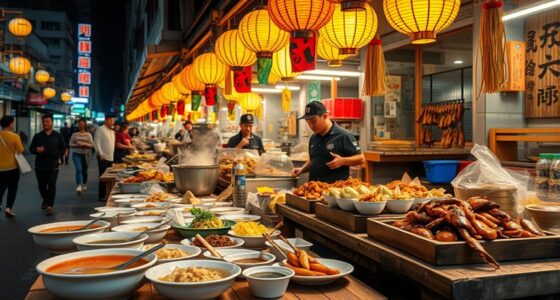Taiwan’s history and culture blend indigenous traditions, colonial influences, and modern innovations. You’ll see this in its diverse languages, vibrant festivals, and unique architecture. Its indigenous peoples have resisted foreign control to preserve their land and customs, while centuries of Dutch, Spanish, Chinese, and Japanese rule have added layers to its identity. Today, Taiwan balances tradition and progress, creating a rich cultural mosaic that continues to evolve—if you keep exploring, you’ll discover even more fascinating stories behind this island.
Key Takeaways
- Taiwan’s indigenous peoples have a history of resistance, cultural preservation, and unique languages, dating back thousands of years.
- European colonization by the Dutch and Spanish introduced new trade, architecture, and conflicts with indigenous tribes.
- The Qing Dynasty expanded into Taiwan, establishing governance, infrastructure, and integrating the island into China.
- The Japanese colonial era (1895–1945) brought modernization, infrastructure development, and cultural suppression efforts.
- Modern Taiwanese society features a blend of indigenous, Chinese, Japanese, and global influences, reflected in festivals, cuisine, and architecture.
Ancient Inhabitants and Indigenous Roots

Taiwan has been inhabited by Malayo-Polynesian indigenous peoples for thousands of years before recorded history. You can trace their origins to a broad Austronesian family that stretches from Sri Lanka to Easter Island. These indigenous groups developed distinct languages and cultures, with at least 20 tribes existing before European contact. Today, 16 of these tribes are officially recognized by Taiwan’s government. Long before large-scale external settlement, indigenous peoples traded with the Asian mainland, especially in jade. Although early Chinese records from as early as 239 CE mention contacts with Taiwan, permanent settlement was limited at first. Their rich history and enduring presence form the foundation of Taiwan’s diverse cultural landscape today. Recent research into sound healing science suggests that traditional practices among some indigenous groups may have incorporated musical elements for healing and spiritual purposes.
European Colonial Encounters and Early Settlements

You see how the Dutch and Spanish established early colonies in Taiwan, each vying for control and trade routes. These encounters brought significant interactions with indigenous peoples, often marked by conflict and cooperation. As settlers moved in, they transformed the island’s landscape and cultural landscape, laying the groundwork for Taiwan’s complex colonial history. The influence of European colonial powers also introduced new interior design ideas and architectural styles that can still be seen in historic sites today.
Dutch and Spanish Colonies
During the early 17th century, European powers began establishing footholds on the island, driven by ambitions for trade and resource control. The Dutch arrived in 1624, setting up a colony in southwestern Taiwan, focusing on trade, resource extraction, and spreading Christianity. They promoted Han Chinese migration, which increased settlement but often led to violent clashes with indigenous groups. The Spanish briefly controlled northern Taiwan from 1626 to 1642, establishing Fort Santo Domingo in present-day Tamsui. However, the Dutch ousted the Spanish in 1642, consolidating control over the entire island. These colonial efforts introduced new trade networks, altered local power dynamics, and laid the groundwork for future Chinese settlement. Their presence marked Taiwan’s first significant European interaction, shaping its early colonial history. Additionally, the colonial period saw the implementation of European colonial strategies, which influenced local governance and cultural exchanges.
Indigenous-European Interactions
How did the arrival of European colonizers impact the indigenous peoples of Taiwan? You’ll find that Europeans brought new trade, technologies, and conflicts. Dutch and Spanish settlers often clashed with indigenous groups, leading to violence and displacement. Dutch promoted migration of Han Chinese, which increased tensions and altered indigenous societies. The Europeans also introduced new crops, tools, and ideas, but their presence disrupted traditional ways of life. Indigenous groups sometimes allied with or fought against Europeans, shaping Taiwan’s early colonial history. These interactions significantly affected indigenous social structures and their cultural identities.
Early Settler Movements
European settlers arrived in Taiwan in the early 17th century, establishing the first lasting colonial footholds on the island. You’ll find that these early movements shaped Taiwan’s history profoundly. Here are four key aspects:
- The Dutch established a base in the southwest in 1624, focusing on trade and resource extraction.
- The Spanish briefly controlled the north but were expelled by the Dutch by 1642.
- Dutch migration policies brought large numbers of Han Chinese settlers, often leading to conflicts with indigenous peoples.
- In 1661–1662, Ming loyalist Koxinga expelled the Dutch, creating the Kingdom of Tungning, which lasted until the Qing annexation in 1683.
- The migration and settlement patterns during this period significantly influenced Taiwan’s colonial development and demographic makeup.
These early settler movements introduced new cultures, fueled conflicts, and set the stage for Taiwan’s complex colonial history.
Transition to Qing Dynasty Rule and Expansion
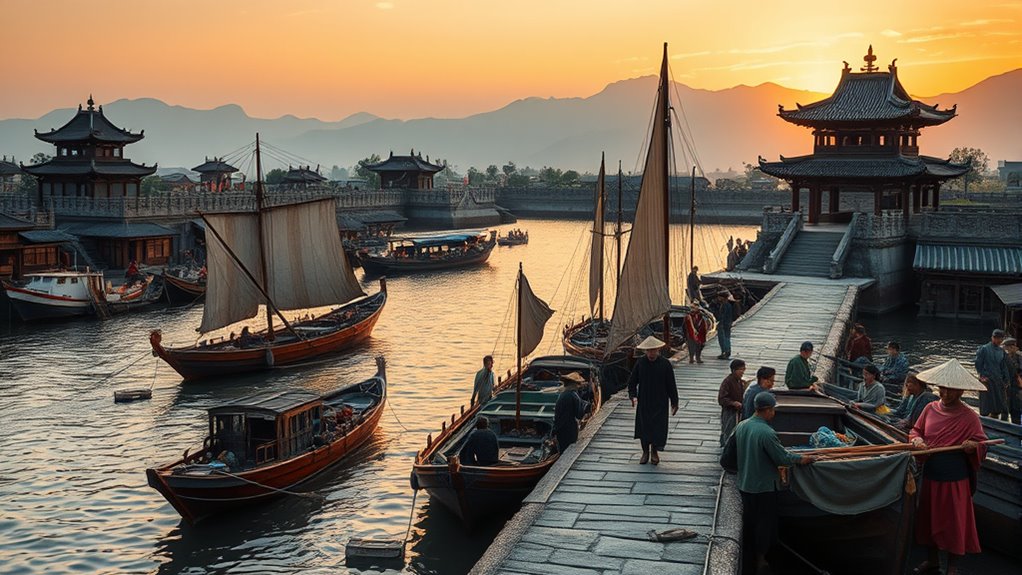
When the Qing Dynasty annexed Taiwan in 1683, they began expanding their control by subjugating indigenous tribes and encouraging Han Chinese settlement. You’ll see that indigenous resistance persisted through efforts to defend their land and culture, despite Qing efforts to consolidate power. Infrastructure projects, like mountain roads, also played a key role in strengthening Qing authority across the island. Additionally, the adoption of influence of Chinese culture further integrated Taiwan into the Qing Empire’s administrative and social systems.
Qing Annexation of Taiwan
The Qing Dynasty’s annexation of Taiwan marked a significant turning point in the island’s history, transforming it from a peripheral territory into an official province of China. You’ll see this shift through several key developments:
- Qing forces gradually subjugated local tribes, expanding their control over the island.
- They promoted Han Chinese settlement, especially in coastal and fertile areas.
- Infrastructure projects, like mountain roads, improved connectivity and administration.
- Taiwan’s status as a provincial entity was formalized in 1887, solidifying Qing authority.
- The annexation process involved territorial expansion, which helped integrate Taiwan into China’s political system.
This annexation aimed to integrate Taiwan into China’s political and economic system, laying the foundation for future development and control. It marked the beginning of sustained Chinese governance that would influence Taiwan’s cultural and societal landscape.
Indigenous Resistance Efforts
As Qing forces pushed inland to consolidate control over Taiwan, indigenous peoples actively resisted these efforts to defend their land and autonomy. You might have fought back through guerrilla tactics, attacking Qing troops and disrupting their supply routes. Many tribes united to oppose the expanding Qing authority, refusing to surrender their territories easily. Some staged large-scale uprisings, such as the Rukai and Paiwan rebellions, seeking to reclaim their independence. Despite Qing military superiority and efforts to subjugate them through military campaigns and forced relocations, resistance persisted. Your ancestors valued their land’s sovereignty and fought fiercely to maintain their cultural identity amid Qing expansion. Their persistent efforts reflected a deep desire to preserve their way of life against external domination. Additionally, the indigenous resistance was often fueled by their cultural identity, which they prioritized over external control.
Infrastructure Development Initiatives
Following the Qing dynasty‘s decision to formally incorporate Taiwan as a province in 1887, significant infrastructure development initiatives began to shape the island’s landscape. You can see this in several key projects:
- Road Construction: Mountain roads were built around 1874 to improve access and control, connecting remote areas and facilitating trade.
- City Planning: Taipei was officially designated the capital in 1893, leading to urban development and modernization efforts.
- Fortifications: Defensive structures were erected to protect against external threats and internal unrest.
- Public Works: Infrastructure such as administrative buildings and communication networks were established to consolidate Qing rule and promote settlement.
- Architectural Techniques: The adoption of construction methods during this period contributed to the durability and expansion of infrastructure across Taiwan.
These initiatives laid the foundation for Taiwan’s transformation into a strategically essential and administratively organized territory.
Japanese Colonial Era and Modernization Efforts
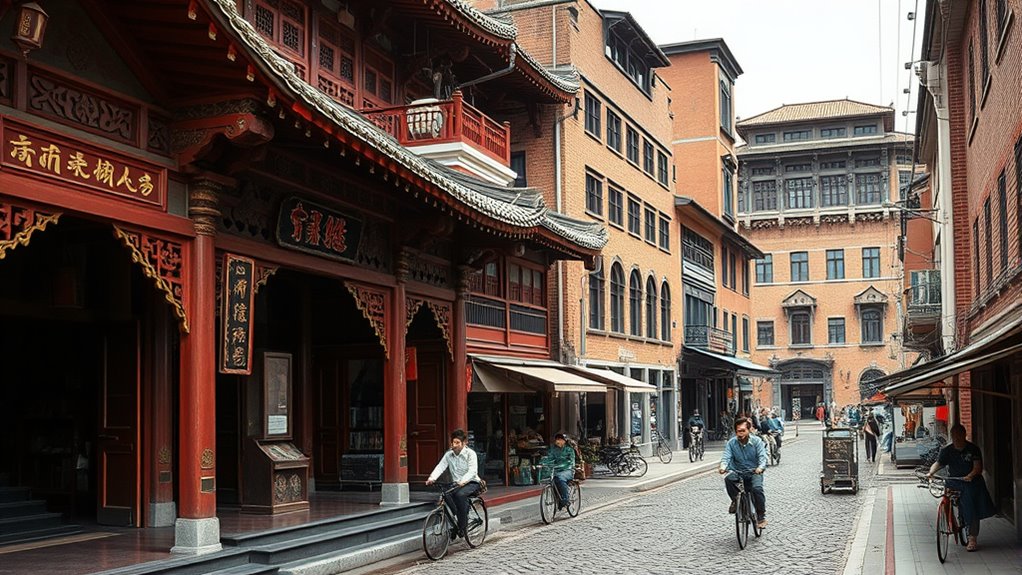
During the Japanese colonial period from 1895 to 1945, Taiwan underwent significant modernization as Japan implemented policies aimed at transforming the island into a model colony. You see, they built railways, bridges, and roads that improved transportation. Education and public health also advanced, with new schools and hospitals established. These efforts boosted economic growth and connected remote areas. However, this development often came at the expense of indigenous cultures and resistance. To deepen your understanding, consider this table:
| Aspect | Impact | Meaning |
|---|---|---|
| Infrastructure | Modern roads, railways, urban growth | Accelerated economic progress |
| Education | Universities, schools for locals | Knowledge transfer, modernization |
| Public Health | Hospitals, sanitation improvements | Increased life expectancy |
| Cultural Policy | Suppression of indigenous traditions | Cultural assimilation efforts |
| Resistance | Uprisings like Musha Uprising | Indigenous resistance to change |
Additionally, the period saw the spread of modernization efforts, which influenced various aspects of Taiwanese society and laid the groundwork for future development.
Post-World War II Changes and Political Shifts

After decades of modernization under Japanese rule, Taiwan found itself at a crossroads once World War II ended. You experience a period of dramatic change, shaping Taiwan’s political landscape. Here are four key shifts:
- The ROC takes control in 1945, ending Japanese rule and establishing authority.
- The 228 Incident in 1947 sparks anti-government unrest, leading to martial law.
- In 1949, the ROC government retreats to Taiwan after losing the Chinese Civil War.
- The island shifts to democracy, ending martial law in 1987 and fostering political reform.
These events transform Taiwan from a war-torn territory into a vibrant, independent society. You witness the emergence of a unique identity, balancing old traditions with modern democratic values amid ongoing political tensions.
Indigenous Cultures and Contemporary Preservation
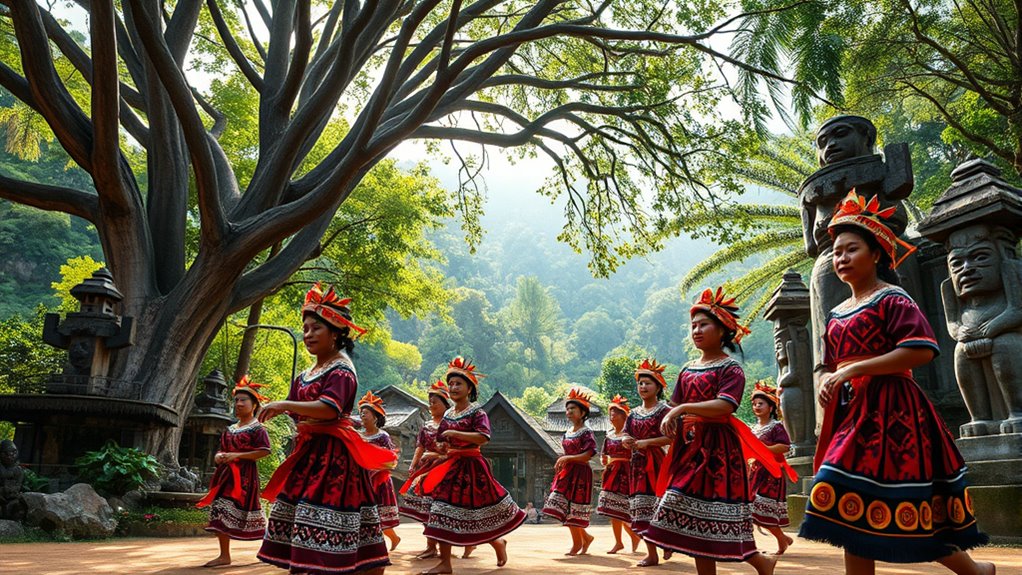
Taiwan’s indigenous cultures continue to thrive amid modern challenges, as efforts to preserve their languages, traditions, and identities gain momentum. You can participate in programs that revive native languages, which face decline due to assimilation and modernization. Indigenous communities actively promote cultural practices through festivals, craft workshops, and storytelling, helping to sustain their unique identities. The government recognizes at least 16 tribes, supporting their rights and cultural heritage through policies and education. Museums and cultural centers showcase indigenous history, art, and traditions, fostering awareness and pride. Young indigenous people are increasingly involved in cultural preservation, balancing modern life with ancestral roots. These initiatives help ensure that Taiwan’s rich indigenous legacy remains essential and celebrated amid an evolving society.
Cultural Mosaics: Blending Traditions and Influences

Taiwan’s cultural landscape is a vibrant mosaic shaped by centuries of diverse influences, merging indigenous traditions with those brought by Chinese settlers, Japanese colonizers, and modern global trends. You can see this blend in everyday life, from architecture to cuisine.
Here are four key aspects of this cultural fusion:
- Traditional festivals like Lunar New Year and indigenous rituals coexist, reflecting shared and diverse beliefs.
- Architecture combines Japanese colonial styles with modern skyscrapers and preserved indigenous structures.
- Cuisine features Chinese flavors, Japanese influences, and local ingredients, creating unique dishes like bubble tea and stinky tofu.
- Languages spoken include Mandarin, Taiwanese Hokkien, Hakka, and indigenous tongues, illustrating linguistic diversity.
This mosaic continually evolves, preserving roots while embracing new influences that define Taiwan’s identity today.
Taiwan’s Society: From Modernization to Global Identity
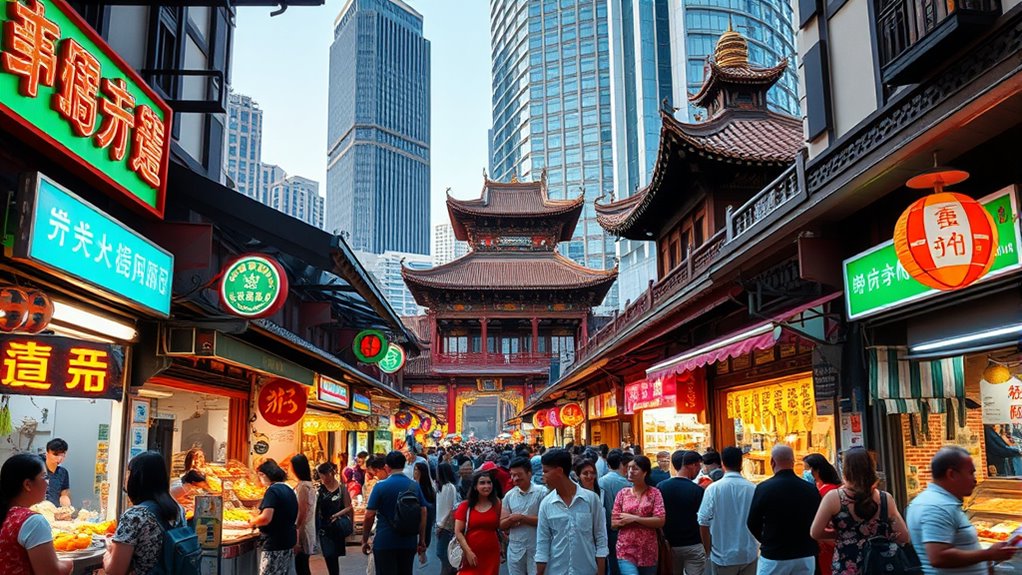
The rich cultural mosaic of Taiwan has laid a strong foundation for its modern society, where traditional customs coexist with rapid development and global engagement. You see this blend in everyday life, from vibrant indigenous festivals to cutting-edge technology hubs. Taiwan’s society has transformed from a rural, agricultural community into a dynamic, modern nation that embraces innovation and international connections. Its democratic system and economic growth have fostered a sense of national identity rooted in resilience and multiculturalism. You’ll notice how Taiwanese people value their indigenous heritage while actively participating in global trends, education, and cultural exchanges. This balance of tradition and modernity helps Taiwan stand out as a unique society that honors its past while confidently shaping its future on the world stage.
Frequently Asked Questions
How Have Indigenous Languages Influenced Modern Taiwanese Identity?
Indigenous languages shape your modern Taiwanese identity by highlighting unique cultural roots and fostering pride among indigenous communities. They influence contemporary arts, music, and local traditions, enriching Taiwan’s diverse cultural landscape. You can see their impact in place names, festivals, and language revitalization efforts. Embracing these languages helps you appreciate Taiwan’s rich heritage, promotes multiculturalism, and strengthens your connection to the island’s indigenous history and ongoing cultural identity.
What Role Did Trade Play in Early Indigenous Societies?
Trade shaped early indigenous societies more than you might imagine, turning them into bustling hubs of exchange and connection. You’d see tribes trading jade, tools, and crafts across vast distances, creating a web of relationships that stretched from Sri Lanka to Easter Island. This vibrant trade network not only fueled their economies but also spread ideas, culture, and traditions, making these societies incredibly resilient, diverse, and deeply interconnected long before outsiders arrived.
How Did Japanese Rule Impact Taiwan’s Educational System?
Japanese rule modernized Taiwan’s educational system profoundly. You see, they established Taihoku Imperial University in 1928, elevating higher education standards. They also expanded primary and secondary schools, emphasizing science, technology, and public health. As a result, you experience a more structured, accessible education system that aimed to produce skilled workers and officials, laying a strong foundation for Taiwan’s future development. This period deeply influenced Taiwan’s modern educational landscape.
What Are the Main Cultural Differences Between Indigenous and Han Taiwanese?
You’ll notice that indigenous and Han Taiwanese cultures differ in language, traditions, and social practices. Indigenous peoples maintain unique languages, rituals, and spiritual beliefs rooted in their ancestral heritage. In contrast, Han Taiwanese culture is influenced by Chinese customs, festivals, and language, often blending modern and traditional elements. These differences create a rich cultural tapestry, with indigenous traditions preserved alongside Han influences, fostering a diverse and vibrant society.
How Has Taiwan Balanced Traditional and Modern Cultural Expressions?
You might think Taiwan struggles to balance tradition and modernity, but it actually masterfully blends both. You’ll see indigenous rituals alongside bustling tech hubs, ancient festivals next to global trends, and traditional crafts thriving in contemporary art scenes. It’s ironic how Taiwan’s vibrant cultural mosaic refuses to be overwhelmed by modern pressures, instead turning them into opportunities to celebrate its rich, diverse heritage while embracing the future with open arms.
Conclusion
You see Taiwan’s history as a tapestry woven with indigenous roots, colonial influences, and modern innovations. You witness the blending of traditions, the resilience of cultures, and the pursuit of identity. You feel the echoes of ancient customs, the waves of change, and the hope for a vibrant future. You embrace Taiwan’s story as a journey of continuity, change, and unity—an ever-evolving mosaic of past, present, and future.





